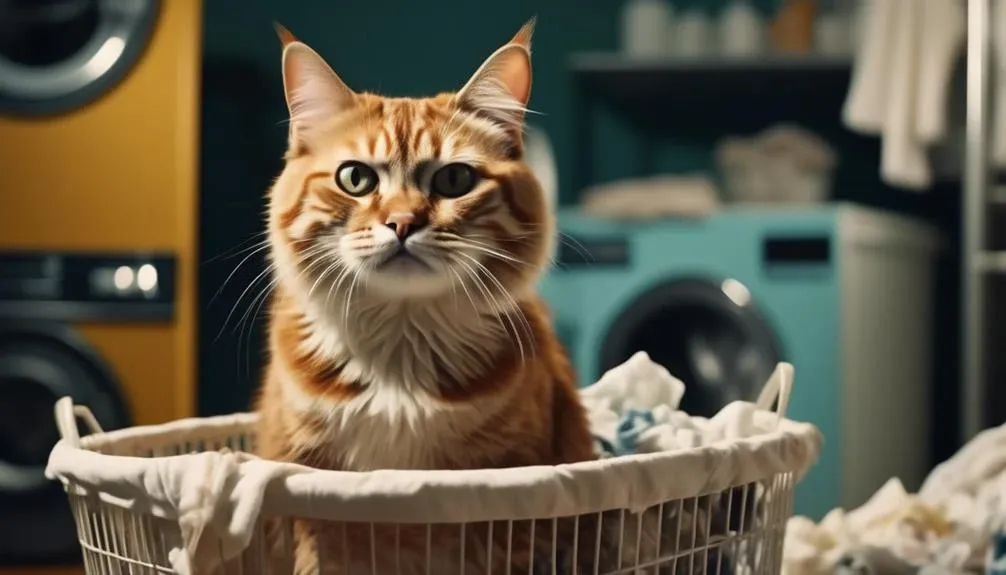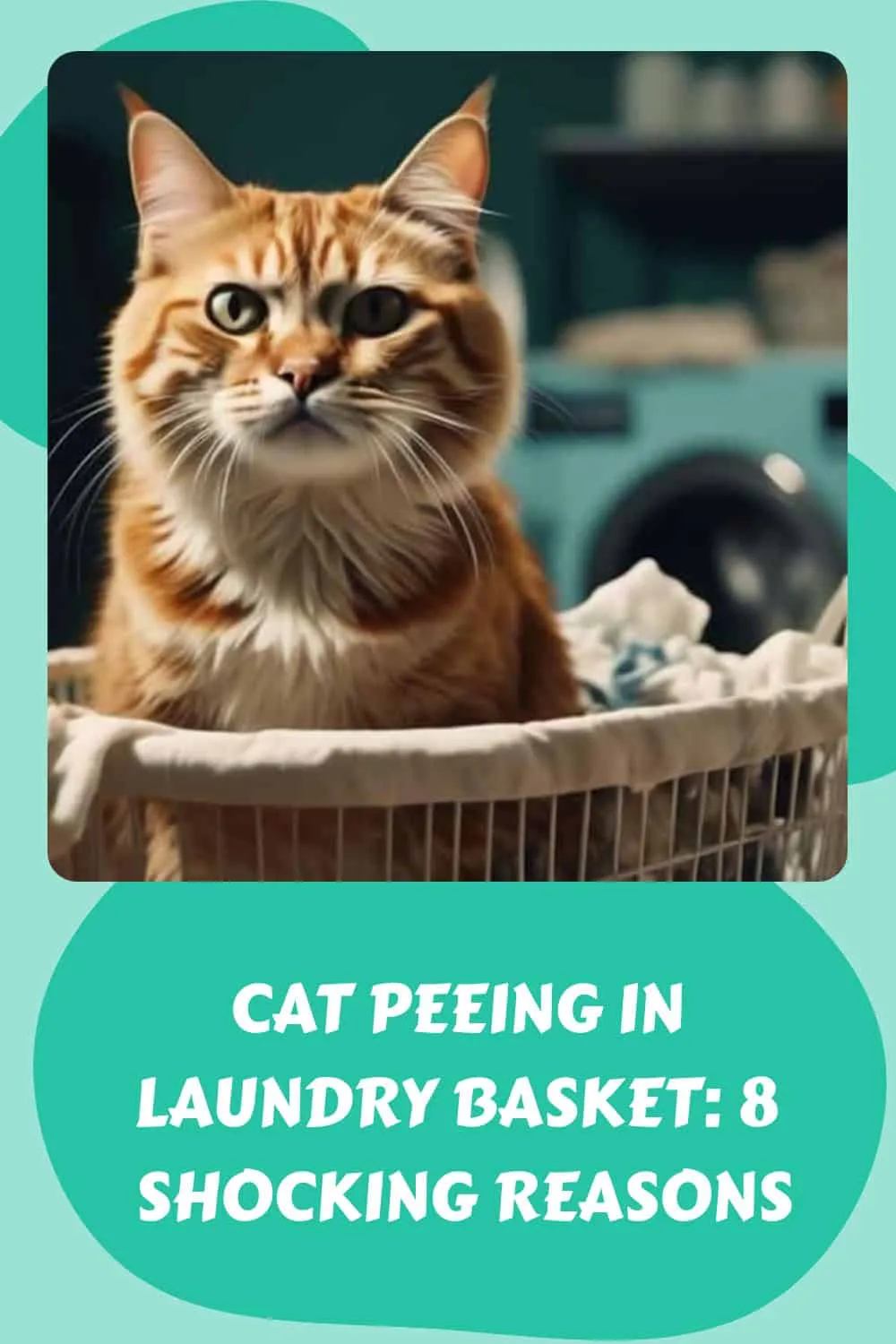The Best Fluffy Pancakes recipe you will fall in love with. Full of tips and tricks to help you make the best pancakes.

Cat peeing in the laundry basket is a perplexing and frustrating issue for many cat owners. While it may be tempting to dismiss it as a random act of defiance, there are often underlying reasons behind this behavior.
In this article, we will explore eight shocking reasons that could shed light on why your cat is choosing your laundry basket as their personal litter box. From issues with litter box maintenance and placement to potential medical conditions and behavioral issues, understanding the root causes is crucial for finding effective solutions.
So, if you're tired of dealing with this unpleasant surprise every time you do laundry, keep reading to uncover the secrets behind your cat's unusual urination habits.
Key Takeaways
- Proper litter box maintenance and placement is crucial for a clean and comfortable environment for cats.
- Having an adequate number of litter boxes is essential, especially in multi-cat households, to prevent accidents and reduce stress.
- Understanding and accommodating a cat's preference for standing while urinating can help prevent inappropriate elimination.
- Stress and anxiety can contribute to a cat peeing in inappropriate places, and it is important to create a calm and predictable environment for them.
Litter Box Maintenance
Litter box maintenance is an essential aspect of cat ownership that requires regular attention and diligence to ensure a clean and comfortable environment for your feline companion. One important aspect of litter box maintenance is odor control.
Cats have a highly developed sense of smell, and if the litter box is not properly maintained, it can lead to unpleasant odors permeating your home. To control litter box odors, it is crucial to choose the right litter. There are various options available, including clumping, non-clumping, scented, and unscented litters. It is important to consider your cat's preferences and any sensitivities they may have when selecting a litter.
Additionally, cleaning the litter box regularly and completely replacing the litter periodically can help prevent odor buildup and ensure a fresh environment for your cat.
Litter Box Placement
Proper placement of the litter box is crucial for creating a comfortable and accessible environment for your cat's toileting needs.
When it comes to litter box placement, there are a few key factors to consider. First and foremost, ensure that the litter box is located in a quiet and low-traffic area of your home. Cats prefer privacy when using their litter box, so placing it in a secluded spot will help reduce stress and anxiety.
Additionally, make sure the litter box is easily accessible to your cat at all times. This means avoiding any obstacles or barriers that may prevent them from reaching the litter box when they need to.
Number of Litter Boxes
When considering the placement of your cat's litter box, it is also important to take into account the number of litter boxes available to them. Here are three reasons why having an adequate number of litter boxes is crucial for your cat's well-being:
- Cat's territorial behavior: Cats are naturally territorial animals, and having multiple litter boxes allows them to establish their territory more effectively. Each cat should have their own designated litter box to prevent any conflicts or stress related to sharing.
- Multi cat household dynamics: If you have more than one cat, it is essential to provide enough litter boxes to accommodate each cat's needs. Cats may have different preferences or schedules for using the litter box, and having multiple options can help prevent any issues arising from competition or overcrowding.
- Preventing accidents and stress: Insufficient litter boxes can lead to accidents outside the box, as cats may become frustrated or anxious if they cannot access a clean and available litter box. By providing enough litter boxes, you can minimize stress and ensure that your cat has a comfortable and convenient place to eliminate.
Preference for Standing
One important factor to consider when addressing a cat's preference for standing is understanding their natural instincts and behaviors.
Cats have a strong instinct to mark their territory, and one way they do this is through urine marking. Some cats may prefer to pee while standing up as a way to leave a more visible and prominent mark. This behavior can also be influenced by the cat's training and past experiences.
To address this preference, it is essential to provide appropriate training techniques. Encouraging the cat to use a litter box with high sides or a vertical surface may help satisfy their preference for standing while minimizing any mess or damage.
Additionally, providing multiple litter box options throughout the house can give the cat more choices and opportunities to find a preferred peeing position.
Stress and Anxiety
Understanding a cat's preference for standing can also provide insight into the potential role of stress and anxiety in their behavior. Cats are known to exhibit certain behaviors when they are stressed or anxious, and peeing in the laundry basket can be one of them. Here are three key points to consider when it comes to stress and anxiety as triggers for this behavior:
- Environmental changes: Cats are sensitive creatures, and even small changes in their environment can cause stress or anxiety. Moving to a new home, introducing a new pet, or even rearranging furniture can disrupt their sense of security and trigger unwanted behaviors.
- Lack of routine: Cats thrive on routine, and any disruptions to their daily schedule can lead to stress. Changes in feeding times, litter box cleaning routine, or even absence of their owners for extended periods can contribute to their anxiety levels.
- Conflict with other animals: Cats are territorial by nature, and conflicts with other animals in the household can cause them stress. This can be especially true if they feel threatened or if there is competition for resources such as the litter box. Providing separate litter boxes for each cat can help alleviate this stress.
Managing stress and anxiety in cats is crucial for their overall well-being and can help prevent unwanted behaviors like peeing in the laundry basket. Creating a calm and predictable environment, providing enrichment activities, and seeking veterinary advice for additional support can all contribute to stress management and anxiety reduction in cats.
Medical Conditions
Medical conditions can play a significant role in cats peeing in the laundry basket. One common medical reason for this behavior is urinary tract infections (UTIs). UTIs can cause discomfort and pain while urinating, leading cats to associate the litter box with discomfort and seek alternative places to relieve themselves.
If your cat is exhibiting this behavior, it is crucial to seek medical treatment promptly. A veterinarian can diagnose and treat UTIs through medication and other appropriate interventions. It is essential to follow the prescribed treatment plan to alleviate any discomfort your cat may be experiencing and prevent further urinary issues.
Providing a clean and comfortable litter box environment, along with regular veterinary check-ups, can help ensure your cat's urinary health and discourage inappropriate elimination.
Behavioral Issues
Behavioral issues can contribute to cats peeing in the laundry basket and should be addressed to prevent further inappropriate elimination. It is important to understand that cats are creatures of habit, and any disruption or change in their environment can lead to behavioral problems. Here are three common behavioral issues that may cause a cat to urinate in the laundry basket:
- Litter box aversion: Cats may avoid using the litter box due to various reasons such as a negative association with the litter, discomfort while using it, or a preference for a different substrate. Proper litter box training and techniques can help resolve this issue.
- Territory marking: Cats are territorial animals and may mark their territory by urinating in certain areas, including the laundry basket. This behavior can be triggered by stress, anxiety, or the presence of other animals. Identifying and addressing the underlying cause can help eliminate this behavior.
- Inadequate litter box access: Cats prefer to have multiple litter boxes available in different areas of the house. If there aren't enough litter boxes or if they are not easily accessible, cats may resort to using alternative locations, such as the laundry basket. Ensuring sufficient litter box availability and placement can help alleviate this issue.
Environmental Factors
One important factor to consider when addressing cats peeing in the laundry basket is the impact of environmental factors on their behavior.
Litter box hygiene plays a crucial role in a cat's preference for using it. If the litter box is dirty or smelly, cats may seek alternative locations, such as the laundry basket, to relieve themselves. Regular cleaning and maintenance of the litter box is essential to ensure its appeal to the cat.
Additionally, the impact of household noise should not be underestimated. Loud noises or sudden disturbances can cause stress and anxiety in cats, leading them to seek out quieter and more secluded areas, including the laundry basket, to urinate. Providing a calm and quiet environment for the cat can help alleviate this issue.
Conclusion
In conclusion, the behavior of cats urinating in laundry baskets can be attributed to various factors such as litter box maintenance, placement, medical conditions, and behavioral issues. By understanding these underlying causes and addressing them effectively, cat owners can prevent this undesirable behavior.
The article has provided valuable insights into the shocking reasons behind this behavior and offered practical solutions for cat owners to implement. By following these suggestions, cat owners can ensure a clean and stress-free environment for their feline companions.










